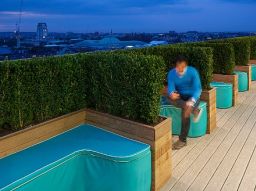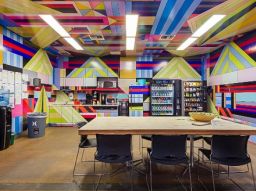Story highlights
Corporations believe that cozy offices boost productivity and creativity.
Studies show that adding plants to a windowless computer lab prompts quicker reaction times.
Greenery helps motivate employees and counter the stresses of working life.
Ideas flow at Google’s London headquarters and so does the whimsy.
The building resembles a townhouse where hipsters have run riot, albeit with the funding of a tech giant.
Rather than sitting in anonymous boardrooms, employees gather in quirky meeting rooms with upholstered walls that pop in cherry red and lime green.
Or they tap on their laptops in offbeat spaces like the “Velourmptious Snug” – a room padded in green velour, and “Granny’s Flat” – a lounge space with mismatched lampshades, rocking chairs and floral print wallpaper.
“As we designed Google’s SuperHQ we thought about family,” says Lee Penson, the founder of the PENSON architecture and design firm. “This HQ is about humans and the building working around them, rather than the other way around.”
Penson centered his vision on the twin notions that people like nice spaces and that people like to feel comfortable.

Read more: How Leonardo DiCaprio inspired a stunning bridge that doubles as a park
“Put these two basic human instincts into place at work and you pretty much have the entire foundation of a successful workplace that keeps people happy,” he says.
It’s hoped that their happiness will translate into innovation and creativity.
Rethinking the office
That simple psychology is fueling a design revolution in workplaces from San Francisco to Seoul.
Sleek and corporate may convey power and success, but too often those traits leave employees feeling disconnected from their working environments. Organic, playful, cozy—these are the new buzzwords in office architecture.
Sven Ehmann, the creative director of publisher Gestalten, highlights some of the firms driving the revolution in WorkScape: New Spaces for New Work.
Among the featured companies is Daum, a Korean IT firm that relocated its headquarters from the city to a tranquil island off the coast of South Korea, and Urban Outfitters, which refitted seven derelict warehouses with waterways and plants.
“They are about creating the right environment for better, more constructive and more innovative work,” Ehmann says. “Ultimately the reason to invest is to make more money.”
At Google, where employees need to keep their creativity on tap, Penson sought to break up the monotony of the modern office block, which can be stultifying and predictable.
The interiors inside Google change constantly. Besides funky meeting rooms there is a rustic cafeteria, a sleek modern library and a rooftop garden with “secret” meeting spaces.
“It’s very much, ‘John, I’ll see you in the corner of the Secret Gardens in 5,’ rather than, ‘John meet me in Meeting Room 5,’” Penson says. “A space that is different to how offices are expected to be makes people behave and feel better.”
Midori House, the London headquarters of global affairs and lifestyle magazine Monocle, embodies that principle.

Chic yet inviting, the emphasis is on quality of life. Johanna Gullichsen’s homely fabrics bring a warmth to Artek’s sleek office stools, and staff benefit from a tree-lined terrace and large windows.
Sophie Grove, a senior editor at the magazine, says there is a sense of order and calm in the space, and that its design influences office culture.
“What really makes it great are the implicit rules at Midori,” she says. “You can’t eat lunch at your desk, for instance, so you will never find yourself next to a scoffing colleague. People are considerate and the aesthetic is part of that.”
Read more: Do these buildings turn you on? The strange psychology of curvy architecture
Back to nature
In December Amazon won approval for its new headquarters in Seattle. The building will consist of three glass orbs filled with hanging gardens, flowering shrubs, and trees that stretch from floor to ceiling.
The new building will serve as a monument to Amazon’s ambitions and also advertise its green credentials. Yet it would be unfair to call the focus on greenery a mere marketing ploy.
On a more functional level the design will help bring out the best in the 1,800 employees who will call it home.
Around the world employers increasingly understand that greenery helps motivate employees and counter the stresses of working life.
“The days of sitting in cubicles without a window in sight are quickly becoming a thing of the past,” says Sofia Borges, an editor of WorkScape. “This trend of incorporating elements of nature and the outdoors into the workplace holds especially true for companies that deal with design and creativity. Such businesses are realizing the economic potential derived from keeping employees stimulated.”
In 2009 Spanish architecture firm selgascano opened their new offices in a forest outside of Madrid. They did not erect a structure, but instead inserted their structure—essentially a glass tube—into the forest floor.
The north-facing wall of the tube consists of a 2mm thick curved window.
“Working under the trees helps you relax, even in stressful situations,” says Paolo Tringali, an Italian architect at the firm. “The most amazing thing is working eye-level with insects. Living alongside them you adapt to the flow and rhythm of the ever-changing nature.”
Exposure to the elements has made Tringali more attuned to his surroundings. He now notices subtle changes in the environment, such as how sunlight softens when a certain type of cloud enters the atmosphere.
Studies suggest that exposure to plants can sharpen people’s minds in other ways.
Virginia Lohr, a professor of horticulture at Washington State University, conducted the first study that links plants with human productivity.
She found that adding plants to a windowless computer lab was associated with quicker reaction times among participants completing a computer task.

Participants in labs with plant life also demonstrated lower levels of stress and reduced blood pressure, and reported feeling more attentive immediately following the task compared to people in an identical room with no plants.
In a separate study, Lohr found evidence that plants can boost a person’s tolerance for pain.
Read more: How do you design a building when your client is God?
Participants in that study were significantly more likely to keep their hand submerged in ice water for at least five minutes when in the presence of plants, including a bamboo palm and a Chinese evergreen.
That research builds on pre-existing studies that have shown patients recovering from major surgery require less pain medication when their windows offer views of trees instead of concrete.
Lohr believes a combination of learned and innate responses help explain why plants soothe us in settings from the office to the classroom to the hospital.
For instance, it’s known that plants can raise relative humidity to levels where people feel more comfortable, and at which people are less likely to develop respiratory ailments and colds.
Another explanation has to do with our long and enduring relationship with the outdoors.
“We have positive feelings when we experience non-threatening elements in nature, such as trees, flowers, and water, that would have been important for human survival many generations ago,” she says. “I think the final answer remains an intriguing mystery.”

















